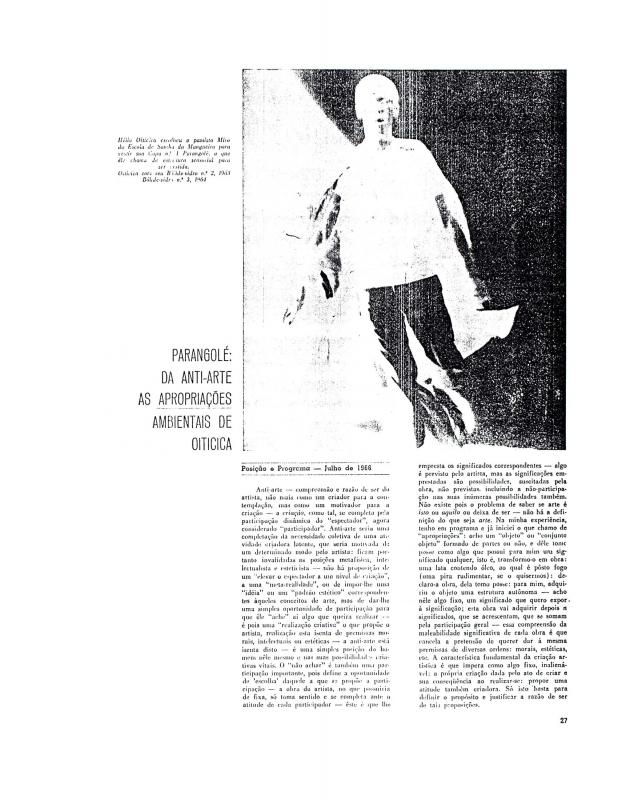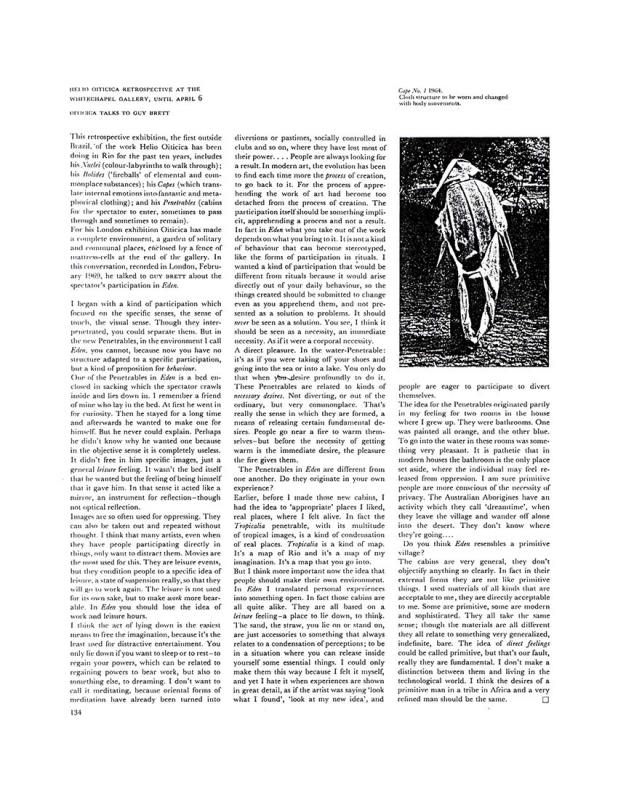Apocalipopótese was an event that took place at the Aterro do Flamengo in Rio de Janeiro in 1968; it featured several artists, including Hélio Oiticica, Rubens Gerchman (1942–2008), Antonio Manuel (b. 1953), and Lygia Pape (1927–2004). This urban-flavored presentation followed in the footsteps of other popular events organized in the same city, such as Orgramurbana, the Festival de Bandeiras, and the Domingos da Criação. Apocalipopótese was part of the so-called “Mês de Arte Pública,” which was organized by the art critic Frederico Morais, and which included, among other presentations, Oiticica’s multicolored capes (Parangolés), the retinal work Ovos [Eggs] by Lygia Pape, and the political-destructive project Urnas Quentes [Hot Ballot Boxes] by Antonio Manuel. While he was in London in the late 1960s, Oiticica described Apocalipopótese as a harbinger of what he planned to explore next.
Hélio Oiticica (1937–80) was a Brazilian Neo-Concrete artist. He started studying painting with Ivan Serpa in 1954 at the Museu de Arte Moderna do Rio de Janeiro. He later joined the Grupo Frente and the Neo-Concrete movement. In addition to his geometric paintings, which he worked on while he was studying with Serpa and was a member of the Grupo Frente, Oiticica produced performance and participatory art. His Parangolés (1964)—capes made with fabrics and recycled materials—were worn by the Mangueira Samba School during their performances. Oiticica also created immersive spaces, such as Nucleus (1959–60), which was an installation constructed from suspended painted wooden slats inspired by the Constructivism of Piet Mondrian. In 1967 Oiticica created the immersive environment Tropicália at the Museum of Modern Art in Rio de Janeiro. Tropicália was an installation consisting of rooms with plants and materials such as water, sand and stones, a parrot, a television set, and various other elements that were representative of Brazilian popular culture. The environment was designed to promote sensory stimulation. Oiticica applied the same principles to Eden, the installation he created in 1969 at the Whitechapel Gallery in London. The name Tropicália was used by Brazilian musicians to describe a new style that combined international music and pop with traditional Brazilian music. The term “Tropicália” was absorbed into popular Brazilian culture and came to signify a uniquely Brazilian essence. In 1970 Oiticica took part in the group exhibition Information at the Museum of Modern Art in New York.
Regarding the capes presented by the author, see his notes from the mid-1960s: “Parangolé: da anti-arte as apropriações ambientais de Oiticica” [doc. no. 1110631], and the article about the event, jointly written by Oiticica and Rogério Duarte “Apocalipopótese no Pavilhão Japonês” [doc. no. 1110621]. While Oiticica was in London, he was interviewed by Guy Brett; in this lengthy interview, Oiticica explained many of his projects and clarified the terminology he used in “Hélio Oiticica Retrospective at the Whitechapel Gallery” [doc. no. 1110627].



